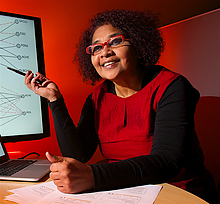 A noted University of Maryland data science expert is part of an international consortium focused on turning large amounts of health data into personalized medical treatments for patients suffering from Alzheimer’s disease or lung cancer.
A noted University of Maryland data science expert is part of an international consortium focused on turning large amounts of health data into personalized medical treatments for patients suffering from Alzheimer’s disease or lung cancer.
Louiqa Raschid, a professor in the Robert H. Smith School of Business, joins other researchers in the European-based endeavor—known as Project iASiS—who are combining information from medical records, imaging databases and genomics data to advance more personalized diagnosis and treatment approaches for patients.
The project is funded by approximately $5 million from the European Commission and includes scientists from 10 research organizations in five countries.
Alzheimer’s is a degenerative neurological disorder that affects more than 45 million people worldwide, including an estimated 5.4 million in the United States. Lung cancer is the most common form cancer in the world, and according the the American Cancer Society, is expected to cause more than 150,000 deaths in the U.S. in 2017.
Raschid, who has an appointment in the University of Maryland Institute for Advanced Computer Studies (UMIACS), will work closely on the iASiS project with Maria-Esther Vidal, a professor of computer science at the Simón Bolívar University in Caracas, Venezuela, who is currently working at the German National Library of Science and Technology.
Raschid and Vidal will apply their expertise in finding patterns in multi-modal pharmacogenomic graphs and electronic health records. These graphs can capture rich knowledge about the interactions of drugs and genes within biological pathways, Raschid says.
Specifically, the researchers are using semantics-based community detection methods to find patterns that may offer clinical insights. They have developed semEP, a semantics-based graph edge partitioning method that can exploit semantic knowledge such as the similarity between a pair of genes, or the type of interaction between a drug and a gene.
“Edge partitioning works well to capture the complex interactions between drugs and genes,” Raschid explains. “We will use semEP to better understand the behavior of drugs and drug families, to rank drugs with respect to several disease phenotypes, and to create drug profiles.”
Electronic health records have recently emerged as a rich source of knowledge that can reflect causal interactions between a drug and a gene target, as well as help identify the potential for adverse drug reactions, Raschid says. However, a known shortcoming is that these datasets are often sparse and “noisy”—meaning that the data entered in the electronic health record may be innacurate, incomplete, or cluttered with information that is not relevant.
Raschid and Vidal believe that by addressing these issues, their research will contribute toward precision medicine approaches that can lead to better outcomes for patients.
They are collaborating with researchers from the Centre for Biomedical Technology at the Technical University of Madrid on examining data associated with lung cancer patients. Raschid and Vidal are also collaborating with Casey Overby, an assistant professor of medicine and health sciences informatics at Johns Hopkins University who is an expert on curating noisy electronic health records.
One approach the research team is considering is to use text mining tools to annotate patient records, thereby improving their quality.
Overby and Vidal have each had visiting appointments at UMIACS, collaborating with Raschid on a drug-induced liver injury case study and developing the semEP tools in use with the team’s current research.
“I am looking forward to further collaboration with other experts to address these data science challenges in electronic health records,” says Raschid. “We think this work could have an impact on how physicians treat patients with serious medical conditions.”
—Story by Melissa Brachfeld